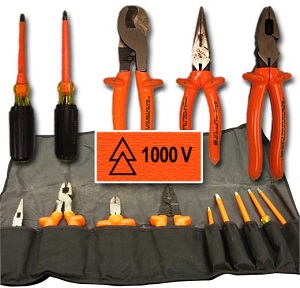We say, "don't take electricity for granted," but what does that really mean and what can employers do to take preventive action? Safety meetings on electrical hazards are critical to keeping employees safe on the job.

Electrical hazards are an area of major safety concerns in many industries and account for a large number of injuries and fatalities. Electrical equipment is found on many jobsites, in warehouses, in shops and employees are exposed to electrical hazards more often than they realize. Employer, manager, owner, or employee... never take electricity for granted!
OSHA Construction Standard 1926.416(a)(1) states that no employer shall permit an employee to work in such proximity to any part of an electric power circuit that the employee could contact the electric power circuit in the course of work, unless the employee is protected against electric shock by deenergizing the circuit and grounding it or by guarding it effectively by insulation or other means.
OSHA General Industry Standard 1910.333(c)(2) Only qualified persons may work on electric circuit parts or equipment that have not been deenergized… Such persons shall be capable of working safely on energized circuits and shall be familiar with the proper use of special precautionary techniques, personal protective equipment, insulating and shielding materials, and insulated tools.
- Recognize electrical hazards such as exposed electrical parts in electrical panels or damaged or frayed electrical cords.
- Ensure exposed electrical equipment is guarded, covered, or locked to prevent accidental contact.
- Avoid contact with exposed electrical parts and report electrical hazards immediately!
OSHA Construction Standard 1926.403(i)(2)(i) …live parts of electric equipment operating at 50 volts or more shall be guarded against accidental contact by cabinets or other forms of enclosures…
OSHA General Industry Standard 1910.333(a)(1) Live parts to which an employee may be exposed shall be deenergized before the employee works on or near them, unless the employer can demonstrate that deenergizing introduces additional or increased hazards…

Only qualified, trained, and equipped persons should work on electrical equipment. If using tools on electrical parts, the tools must be properly insulated and should be rated for the specific voltage expected. Use only the proper tools for the job! Channel locks are NOT fuse pullers!
OSHA Construction Standard 1926.416(d) Fuses. When fuses are installed or removed with one or both terminals energized, special tools insulated for the voltage shall be used.
OSHA General Industry Standard 1910.335(a)(2)(i)(A) Fuse handling equipment, insulated for the circuit voltage, shall be used to remove or install fuses when the fuse terminals are energized.
No matter the industry, Electrical Safety should be a topic of a safety meeting at least once a year. Never assume all employees have "the common sense" to not touch something that could shock them. Weeklysafety.com provides hundreds of safety meeting kits and toolbox talks including topics regarding electrical safety.
If you are interested in Electrical Safety and want to learn more, ElectricalSchool.org has put together an amazing glossary of electrical terms. This comprehensive list includes definitions, related links and videos for every term and acronym you can think of related to electrical work and safety.
.jpeg)
